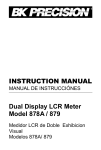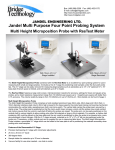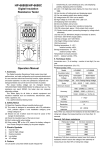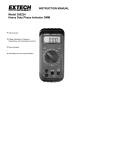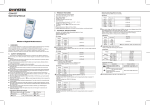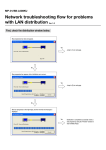Download User`s Manual
Transcript
200A Battery Internal Resistance Tester User’s Manual position of sliding plate based on the length of test batteries and retighten sliding plate setscrew. 4. Align positive and negative electrodes of batteries with those on test probe, and ensure the center of battery is aligned with that of test probe and ensure positive/negative electrodes of battery are in full contact with those of test probe. 5. Switch on power for tester, adjust test range based on the range of battery internal resistance to ensure test accuracy, and record accurate reading. 6. After completion of the test, remove batteries in the opposite direction. Procedures described above can be used as detailed reference. Also, users may manually push sliding plate to ensure full contact between batteries and test probe based on specific production needs and repeat procedures described above. Test method for lead-acid batteries (or finished batteries) Properly connect positive/negative electrodes of test pen with those of batteries (or finished batteries) as described in steps 4, 5 and 5. 200A battery internal resistance tester Internal resistance Voltage display display Power Range switch Test input IX. Routine maintenance This section provides basic information about maintenance and repair. Never attempt to repair this test instrument unless you are qualified repairman experienced in calibration, test and repair. 1. Regularly clean tester casing with wet cloth and neutral cleaner. Never use abrasive material or solvent in cleaning. 2. Dirt and moisture on test probe may affect reading. 4 Overview 200A battery internal resistance tester is an instrument used to test internal resistance and acid membrane damage for batteries. This tester applies 1KHz digital signal (TTL square wave) to test object to test its AC voltage drop and thus identify its internal resistance. Unlike conventional multimeter in operating principle, this tester tests milliohm-level resistance value while multimeter tests ohm-level resistance value. In addition, this tester not only can test resistance value for passive objects but also can test resistance value for active objects while multimeter can only test resistance value for passive objects. Therefore, there is dramatic difference between them. With this tester, you may judge the deteriorated status of batteries according to internal resistance value. Based on Ohm’s law, batteries with lower resistance value have better performance. Therefore, use of this tester to test batteries is the fastest and most reliable method. I. Technical parameters 1. Input power: AC 220V/110V; 2. Power consumption: 8W; 3. Dimension: 250 x 210 x 70 (mm); 4. Weight: 2kg; 5. Display: Digital II. Scope of applications 1. Cadmium-lithium batteries, metal hydride nickel batteries and lithium batteries for mobile phone; 2. Lead-acid batteries and maintenance-free batteries; 3. Also applicable to battery research institutes and production enterprises. III. Important instructions To avoid damage in operation, please follow the following operating procedures: 1. Read through this user’s manual before use. 2. Test time: About 100ms (milliseconds) after full contact for test 1 terminals. 3. Test frequency: 1KHz ±5% square wave. 4. Maximum voltage to be tested: Below 19.99V. 5. Switch on power, check and ensure test probe socket and test pin are in proper contact. 6. To avoid short circuit, please avoid contact between two test pins on the test rack. 7. Never use this tester in environment where flammable substances or gases exist or temperature/humidity is excessively high. 8. Ensure internal resistance and voltage of test batteries are within the test range of the tester. Voltage higher than test range (19.99V) may cause damage to the instrument. 9. If the instrument does not work properly or cannot work, calibrate it as instructed. If such fault remains unsolved, send it for repair. IV. Test range and precision Function Range Test Resolution Test time Precision Input impedance range Internal 200mΩ 1-200mΩ 0.1 mΩ 100ms 100ms - resistance 2Ω 1m-2Ω 1 mΩ 100ms 100ms - Voltage 19.99V 0-19.99V 0.01V 100ms 100ms 10K Notes: a. Test time: About 100ms (milliseconds) after full contact four test terminals. b. Test frequency: 1KHz ±5% square wave (TTL). c. Maximum voltage: Below 19.99V (DC). V. Front panel description Battery internal resistance tester Internal resistance display Voltage display Power Range Test input ①Power switch: (Power On/Off) ②Internal resistance display: Displays internal resistance reading for test batteries (mΩ and Ω). 2 ③ Voltage display: Displays maximum voltage for test batteries (Maximum voltage: 19.99V). ④ Internal resistance range (unit) switch: Used to switch between milliohms (mΩ) and ohms (Ω). At mΩ level, maximum internal resistance for test batteries should not exceed 199.9mΩ. At Ω level, maximum internal resistance for test batteries should not exceed 1.999Ω. ⑤Test input socket: Used to connect test fixture. Switch off power before connection. VI. Test rack ①Rack assembly: Battery test table. ②⑤Test probe fixing rack (Moveable plate): Plates can be moved in the process of test according to battery length to facilitate test. ③④Electrode thimble: Used to connect battery electrodes. Avoid short circuit between test probes. ⑥Connector terminal for test input. VII. Relations between battery internal resistance and voltage (time) Internal resistance value is used to identify battery performance status. Relations between battery internal resistance and voltage (or time) are shown below: (Relational curve between battery internal resistance and voltage) Internal resistance Voltage Change in time VIII. Test procedures Select suitable test rack according to battery types (We may provide special test racks and test pens to meet customers’ specific needs). Below is a description about typical methods for use of test racks. 1. Plug test rack terminal into socket on front panel and tighten screws. 2. Switch on power for the instrument (AC220V/110V). 3. Loosen setscrews at the bottom of test rack sliding plate, adjust the 3 3. To avoid electric shock and damage to the instrument, be sure to switch off power before replacing fuses. 4. Switch off power before replacing test probes. Avoid plugging test probe into power socket. X. Troubleshooting Displays no reading after switching power on 1. If there is no reading display on display screen, switch off power. 2. Check and ensure power is properly connected with main power outlet. 3. If power is connected with power socket, ensure power switch on socket is on. 4. Check and ensure that fuse at the back of the tester is in good conditions. 5. If the problem remains unsolved, please contact manufacturer for repair. 6. Reading on display screen keeps bouncing or remains locked. a. Ensure proper contact between test probe and battery end; b. Ensure no short circuit exists between two test probes on the same side. c. Ensure properly contact and connection between test probe and test rack. d. Ensure proper contact between test rack terminal and socket on front panel. e. Ensure the internal resistance and voltage for test batteries are within rated range or reading will remain locked on display screen. f. If the problem remains unsolved, please contact dealer or manufacturer. 5






